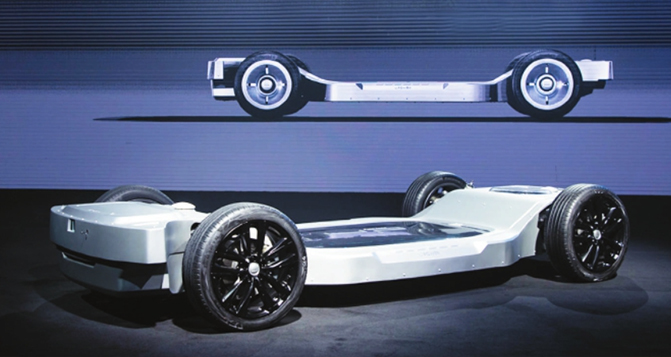After intelligent driving and intelligent cockpit, intelligent chassis is rapidly emerging as a new track for car companies to compete in. In the industry wave of "software defined cars" and "AI driven experience upgrades", intelligent wire controlled chassis is regarded as a key carrier for achieving advanced autonomous driving and improving the overall intelligence level of the vehicle. It not only redefines the standards of vehicle handling and comfort, but also becomes the core technology highland of the smart electric vehicle market in 2025.

1、 The advancement of intelligence has spurred a revolution in chassis systems
With multiple car companies announcing the implementation schedule of L3 level and above autonomous driving, the limitations of traditional mechanical chassis in terms of control accuracy and response speed are becoming increasingly prominent. The lag of its mechanical transmission has become one of the bottlenecks restricting the development of advanced intelligent driving. The intelligent wire controlled chassis achieves human-machine decoupling by replacing mechanical connections with electrical signals, greatly improving system response efficiency and providing key support for the intelligent driving execution layer. Industry consensus believes that L3 and above autonomous driving must rely on key technologies such as wire controlled steering, and its decoupling characteristics can eliminate the physical connection between the steering wheel and the wheels, freeing up cabin space and laying the foundation for future autonomous driving.
At the same time, the rapid expansion of the new energy vehicle market is also driving the transformation of chassis systems towards intelligence. Electric vehicles require higher energy management efficiency, and line controlled braking technology can improve braking energy recovery efficiency by about 17%, significantly enhancing endurance. The fully active suspension system optimizes aerodynamic performance and improves battery layout structure by adjusting damping and vehicle height in real-time. At present, some car companies have utilized technologies such as motor vector control and intelligent hydraulic suspension to achieve innovative functions such as "turning in place" and "pre aiming road adaptation", promoting the chassis from traditional passive bearing to active control, and becoming an important lever for differentiated competition of new energy vehicle models.
2、 Chassis intelligence: from line control to domain control
As one of the "three major components" of traditional fuel vehicles, the chassis has a basic structure including transmission system, driving system, steering system, and braking system. In the wave of electrification, engines and transmissions are gradually phasing out of the mainstream, but the chassis system remains critical and is given higher requirements for intelligent integration.
Line control technology is the core path of the evolution of chassis intelligence. The basic principle is to capture the driver's operation intention through sensors, convert it into electrical signals, and then output instructions to the executing mechanism after analysis by the controller. Compared to mechanical structures, wire control systems have advantages such as fast response, high precision, and flexible layout. At present, wire controlled throttle and gear shifting have been widely used due to their early development; The penetration rate of wire controlled suspension is still low due to cost limitations; However, due to their complex technology, wire controlled motion and wire controlled steering are still in the stage of popularization and climbing.
On the basis of online control technology, the chassis system is further moving towards "domain control". With the increasing computing power of in vehicle ECU, the industry has begun to promote the control mode of unified coordination of multiple chassis functions by central domain controllers, breaking the original isolated subsystem boundaries and achieving deeper collaborative operation and efficiency optimization.
3、 Technical restructuring and experience upgrade
Intelligent chassis not only improves vehicle performance indicators, but also fundamentally optimizes the driving experience:
In terms of response, the transmission of electrical signals has reduced the system delay from hundreds of milliseconds in traditional machinery to the level of 10 milliseconds, and the braking distance per hundred kilometers can be shortened by nearly 9 meters;
In terms of handling, the wire controlled steering system can dynamically adjust the steering ratio based on the vehicle speed and body state, significantly improving the stability of high-speed driving;
In terms of safety, in order to meet the functional safety requirements of high-level autonomous driving, intelligent line control systems generally adopt designs such as multi-sensor redundancy and dual motor backup, and can support ISO 26262 ASIL-D safety standards, ensuring that the system remains reliable in extreme conditions.
From the perspective of application implementation, intelligent chassis is currently mainly focused on high-end new energy vehicle models. For example, in the price range of 300000 to 500000 yuan, multiple brands have launched high-end chassis systems equipped with "air suspension+CDC+rear wheel steering". There are predictions that by 2025, the penetration rate of intelligent chassis in this niche market will exceed 50%. At the same time, local supply chain enterprises have also achieved breakthroughs in key components such as line control valve bodies and air suspensions, driving system costs to continue to decline. Taking air suspension as an example, its single set cost has decreased from 30000 yuan in 2019 to around 10000 yuan currently, making mainstream models priced between 150000 and 250000 yuan gradually capable of being equipped.
4、 Market prospects and investment frenzy
According to industry predictions, by 2030, the size of China's intelligent chassis market is expected to exceed 143.5 billion yuan, with a compound annual growth rate of over 25%. Future technology will no longer be limited to independent operation of subsystems, but will develop towards the direction of deep integration of "chassis+intelligent driving" - for example, by using laser radar to pre identify road bumps and actively adjust suspension damping; Alternatively, high-precision maps can be used to achieve adaptive chassis adjustment throughout the entire road section, ultimately building an integrated collaborative control ecosystem of "human vehicle road cloud".
This process has also attracted a large influx of capital. Zhou Xiaochun, a partner at Noyan Capital, stated that the investment and financing boom in the domestic intelligent chassis market will continue. With the gradual mass production of new technologies such as EMB (Electronic Mechanical Braking), CDC continuous damping control, and magnetorheological suspension, intelligent chassis is driving the automotive industry from the mechanical era to the era of electronic control and intelligence.
Several industry experts have pointed out that the profound significance of intelligent chassis lies not only in improving the handling and comfort of bicycles, but also in promoting the development of the entire automotive architecture towards centralized control, software driven, and continuous evolution. It is no longer a single hardware component, but an important cornerstone for future intelligent vehicles to achieve global intelligence.

